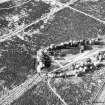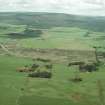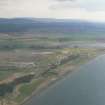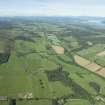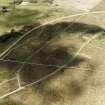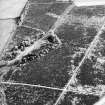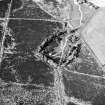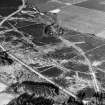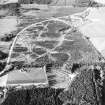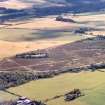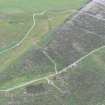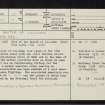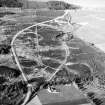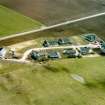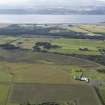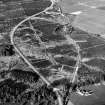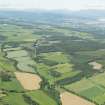Culloden Moor, Battlefield
Battle Site (18th Century)
Site Name Culloden Moor, Battlefield
Classification Battle Site (18th Century)
Alternative Name(s) Culloden Muir; Culloden Battlefield; Battle Of Culloden
Canmore ID 14201
Site Number NH74NW 17
NGR NH 7422 4498
NGR Description Centred on NH 7422 4498
Datum OSGB36 - NGR
Permalink http://canmore.org.uk/site/14201
- Council Highland
- Parish Daviot And Dunlichity
- Former Region Highland
- Former District Inverness
- Former County Inverness-shire
NH74NW 17.00 centred 742 450
NH74NW 17.01 7497 4526 Cumberland's Stone
NH74NW 17.02 7437 4502 Grave of the English
NH74NW 17.03 7425 4499 Graves of the Clans
Extends onto map sheet NH74SW:
For Culloden Moor, King's Stable Cottage (NH 7333 4484), see NH74SW 1.
For Culloden Moor, Prince Charlie's Stone (NH 7376 4438), see NH74SW 2.
For Culloden Moor, Well of the Dead (NH 7431 4497), see NH74SW 20.
For Culloden Moor, Old Leanach Farmhouse (NH 7450 4499), see NH74SW 21.
For Culloden Moor, Jacobite Memorial Cairn (NH 7417 4498), see NH74SW 30.
(Name: NH 742 450) Site of the Battle of Culloden (NAT) 16th April 1746 (NAT)
OS 6" map, (1968)
The Battle of Culloden took place on the 16th April 1746 between about 4500 men under Charles Edward Stuart and a Hanoverian force of 9000 led by the Duke of Cumberland. The battle positions were as shown on plan and the result was an overwhelming victory for the Hanoverians. A modern memorial cairn bearing an appropriate inscription has been erected at a spot where there was intense fighting. The associated memorials etc, noted on NH74NW 17.1 - 17.5 and the ground on which they stand are owned by the National Trust for Scotland.
M Brander 1975; R Prentice 1976.
NH 741 447. The NTS have worked steadily on the restoration of Culloden battlefield towards how it would have looked at the time of the battle. After an analysis of contemporary plans of the battlefield, an attempt was made to locate a small polygonal enclosure in which the English dead are said to have been buried, and to assess whether any of the surviving enclosures could date from the time of the battle. All of the current drystone enclosures seem to date from around 1845, but to some extent follow the approximate lines of the larger enclosure shown on plans of 1746. As anticipated, no trace of the turf dyke could be found. However. a geophysical survey of the field is now planned. in the hope of locating the English graves and from there surmising the position of the turf dyke: the polygonal parish boundary. which seems to mimic the dyke, should provide supporting evidence if the geophysical survey is successful.
Sponsor: National Trust for Scotland.
R Turner 1994h.
Non-Guardianship Sites Plan Collection, DC23299- DC23301, 1872,1923 & 1924.
Note (1979)
Culloden, Battlefield NH 73 44, 74 44, 74 45, NH74NW 17 NH74SW 1 & 2
The following monuments associated with the Battle of Culloden (16th April 1746) have been given statutory protection under the Ancient Monuments and Archaeological Areas Act 1979; the Graves of the Clans (NH 742 450); the Well of the Dead (NH 743 449);the King's Stables (NH 733 448); Old Leanach House (NH 745 450); the stone associated with Prince Charles Edward Stuart (NH 737 443); the stone commemorating the Graves of the English (NH743 450), and the Cumberland Stone (NH 749 452).
RCAHMS 1979
Aerial Photography (1988)
Aerial Photography (1994)
Geophysical Survey (1995)
NH 745 450 and NH 740 448 Resistance and gradiometer surveys were conducted on two discrete areas of the battlefield at Culloden: the area around Old Leanach and an area in the extreme W of the land owned by NTS.
The project was instigated after cartographic research, and had three main aims: to establish the presence of remains of other structures around the extant building at Old Leanach; to locate the remains, if any, of a pentangular turf-built enclosure at the W of the battlefield; and to identify the position of the reputed 'grave of the English dead'.
The survey around Old Leanach successfully identified two regions of high resistance of similar surface area to the extant building which probably reflect the footings of associated buildings.
The larger survey to the W identified nothing of any great antiquity, save for a very faint anomaly noted on the gradiometer survey. This anomaly had a magnitude little greater than the background, and would be very difficult to view as significant, if it were not aligned on a similar orientation to the cartographic evidence for the turf dyke. Only excavation could confirm this interpretation.
Sponsor: National Trust for Scotland.
T Neighbour 1995.
Magnetometry (1995)
Project (June 2000 - September 2001)
NH 741 447 In June 2000 and September 2001 a programme of fieldwork was carried out on the site of the Battle of Culloden (NMRS NH74NW 17.00), which took place on 16th April 1746. The fieldwork included the following elements:
Topographic survey of the battlefield area.
Ground-probing radar (GPR) survey of the clan graves and the 'Field of the English' (where Government troops are presumed to have been buried).
Metal-detector survey of the 'Field of the English' and the area between the Interpretation Centre and the clan graves.
Geophysical survey of the area around Old Leanach Cottage and the area between the Interpretation Centre and the clan graves.
Excavation of the denuded walled feature adjacent to Old Leanach Cottage, traditionally referred to as the 'Red Barn'.
The project has provided a new insight into the battle through the examination of archaeological evidence. The metal-detector survey revealed that both the Jacobite and Hanoverian lines extend further to the S than previously believed. Geophysical survey and excavation of the area adjacent to Old Leanach Cottage failed to reveal any evidence for activity pre-dating the 19th century. GPR survey revealed the presence of grave pits beneath the mounds in the clan cemetery.
Fuller results of the project are scheduled for broadcast on BBC2 in early 2002. Reports on this work will appear in the book which will accompany the TV series and a full academic report, probably to appear in monograph form with the other five British battlefields investigated as part of the project. The co-operation of the NTS is gratefully acknowledged.
Sponsors: Optomen Television Ltd, BBC, Penguin Publishers.
T Pollard and N Oliver 2001.
Metal Detector Survey (June 2000 - September 2001)
Measured Survey (June 2000 - September 2001)
Ground Penetrating Radar (June 2000 - September 2001)
Ground penetrating radar survey.
Project (April 2005 - April 2005)
Survey; excavation NH 741 447 A multi-faceted investigation was undertaken in April 2005 at Culloden battlefield (NH74NW 17.00) as part of the programme of site re-assessment related to the construction of a new visitor centre. The results of this fieldwork will be used to inform the redisplay of the battlefield and the site interpretation presented to visitors. Metal detector survey, geophysical survey and limited excavation were combined to pursue a number of research avenues relating to the location, progress and character of the battle and the role of the landscape.
Metal detector survey was carried out across a wide transect passing roughly E-W through the Field of the English, the reconstructed Leanach enclosure and the area beyond. This resulted in a considerable assemblage of battle-related debris, including around 250 lead balls of various types. This material represents several stages of the battle, including the Government artillery barrage, the Jacobite charge, hand-to-hand fighting on the Government left, and the fighting withdrawal of the Jacobite force.
Geophysical survey was used in an attempt to locate the unmarked graves of the Government troops in the so-called Field of the English. Both magnetometer and resistivity techniques were deployed, with some promising results. In addition to possible prehistoric activity, in the form of a circular feature, a large anomaly may represent a burial pit, especially when viewed in conjunction with the pattern of artefact deposition.
Finally, the hand-excavation of two evaluation trenches across geophysical anomalies, first identified after survey in 2000, was carried out in an effort to locate the buried remains of a building related to the farmstead now represented by Old Leanach Cottage. One of these trenches contained a linear trench, which may relate to the foundation cut for the wall of a building, possibly related to the farmstead.
Report lodged with Highland SMR and NMRS.
Sponsor: NTS.
T Pollard 2005
Magnetometry (April 2005 - April 2005)
Survey; excavation NH 741 447 Magnetometry survey.
Report lodged with Highland SMR and NMRS.
Sponsor: NTS.
T Pollard 2005
Resistivity (April 2005 - April 2005)
Survey; excavation NH 741 447 Resisitivity survey.
Report lodged with Highland SMR and NMRS.
Sponsor: NTS.
T Pollard 2005
Metal Detector Survey (April 2005 - April 2005)
Excavation (April 2005 - April 2005)
Project (December 2005)
NH74SW 58 741 447
NH 741 447 As part of the continued archaeological works related to the construction of a new visitor centre and reinterpretation of the 1746 battlefield, the National Trust for Scotland commissioned GUARD to continue the metal detector survey begun in April 2005. In December 2005, the areas corresponding to the new building footprint and the associated car park were surveyed. Low densities of buttons and musket balls were recovered, suggesting that sporadic fighting took place behind the main Government Left, possibly in mopping-up operations involving Jacobites who had broken through the Government line. Lead casting debris and a silver King's Shilling dated to the 1690s may represent evidence for the site of the temporary Government camp established on the field after the battle.
In April 2006, a programme of ground-penetrating radar survey was carried out over the Jacobite Graves in the Clan cemetery. As suggested by earlier work, this indicated pits beneath each of the mounds.
In June 2006, the Field of the English was subject to further metal detector survey in order to define the location of the Government left flank. This resulted in the recovery of a number of musket balls, buttons and other battle debris.
In August 2006, work began on the construction of the new visitor centre. Works were monitored as part of an archaeological watching brief. Thus far, one undated stone-packed pit has been recorded. Other than small amounts of metal detector finds, no archaeological features associated with the battle have been identified. The watching brief continues.
Archive to be deposited in NMRS.
Sponsor: National Trust for Scotland.
T Pollard, 2006.
Ground Penetrating Radar (April 2006)
In April 2006, a programme of ground-penetrating radar survey was carried out over the Jacobite Graves in the Clan cemetery. As suggested by earlier work, this indicated pits beneath each of the mounds.
T Pollard, GUARD April 2006
Watching Brief (August 2006)
In August 2006, work began on the construction of the new visitor centre. Works were monitored as part of an archaeological watching brief. Thus far, one undated stone-packed pit has been recorded. Other than small amounts of metal detector finds, no archaeological features associated with the battle have been identified. The watching brief continues.
Archive to be deposited in NMRS.
Sponsor: National Trust for Scotland.
Watching Brief (August 2006 - March 2008)
NH 742 450 (centred on) This is an interim summary of the outcomes of this monitoring project, ahead of the full
report being completed and submission of a final account for the next edition of DES. A full monitoring programme was undertaken, August 2006 and March 2008, on the construction of a new NTS visitor centre.
Previous work in the battlefield area had shown that the paths representing the opposing Government and Jacobite battle lines were incorrectly positioned, and new paths were laid out along more accurate alignments. The footpaths in the core area of the battlefield, known as the Clan Cemetery and designated a SAM, were also realigned and brought back to run along the old course of the B9006 road which ran through the cemetery area until the 1970s.
Earlier investigations by geophysical and metal detector surveys, controlled excavation and test pitting had suggested that the development footprint of the new visitor centre and ancillaries would be archaeologically safe, and this proved to be the case. No significant structural features were found in any of the excavated areas, and artefact retrieval was only achieved by the ongoing metal detector surveys of the topsoil, subsoil and spoil. This produced a few musket balls and other assorted battle-related objects, most of which showed signs of heavy plough damage. The footpath monitoring results were also negligible, with no structural discoveries and only a handful of minor artefacts.
One battle-related question which was partially resolved was the discovery of a much older (albeit undated) trackway sequence under the former B9006 road into the battlefield from the W. This is in keeping with contemporary maps which show a track through the battlefield to Leanach cottage, and this may have influenced how the conflict progressed.
Apart from validating the previous predictions of archaeologically safe zones, the value of the monitoring was
in its ability to identify the degree of post-1746 agricultural improvement and sustained forestry programmes across the battlefield. Both regimes brought extensive impacts and terrain modifications which can now be quantified and related to the survivability of battle features and any earlier deposits and structures in the immediate area.
Archive: RCAHMS (intended). Report: Highland HER/SMR and RCAHMS
Funder: NTS
David Lynn (GUARD), 2008
Metal Detector Survey (June 2006)
In June 2006, the Field of the English was subject to further metal detector survey in order to define the location of the Government left flank. This resulted in the recovery of a number of musket balls, buttons and other battle debris.





























